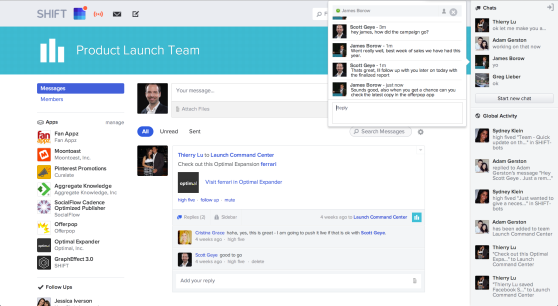 Salesforce says it has the world’s only unified social marketing suite. Adobe says its marketing cloud is a single service that includes everything digital marketers need to get ahead.
Salesforce says it has the world’s only unified social marketing suite. Adobe says its marketing cloud is a single service that includes everything digital marketers need to get ahead.
Shift begs to differ.
“We’re bringing the market alternative to the closed, rigid marketing cloud that Adobe and Salesforce have created,” Shift CEO James Borow told me yesterday. “If you look at their marketing clouds, it’s really only about companies they’ve acquired and built. But the problem is, as the market moves, you really can’t acquire or build companies fast enough.”
The concept of a marketing cloud is a interoperable suite of tools that together provide the digital marketer — and today, is there any other kind? — everything they need to find, understand, attract, engage, monitor, communicate, and track consumers, fans, and customers.
Today, that’s largely about search and social.
So what Shift has done is assemble what Borow considers an all-star cast of digital marketing tools together in one platform. It’s not buying them all and not integrating them all into one inseparable suite, but making them all available in one environment, with a certain amount of interoperability, data share, and single sign in.
“Ultimately, we’re trying to break down these silos of communication,” Burrow says.
Today, those tools include:
- Aggregate Knowledge (media buying intelligence platform)
- Convertro (conversion-tracking and ROI optimization)
- Curalate (marketing and analytics for Pinterest and Instagram)
- Expion (social media management)
- Fan Appz (personalized social media marketing)
- Kenshoo (search and social ad tools)
- Moontoast (rich media social ad creation)
- Offerpop (social media marketing campaign platform)
- Optimal Analytics (Facebook advertising and analytics)
- SocialFlow (conversion tool for Twitter and Facebook)
- The Trade Desk (online media buying platform)
- GraphEffect (social advertising)
Shift has brought all these tools together within one network with its own graph, somewhat analogous to Facebook’s social graph, that tracks marketing actions and attention-needed data points within each tool and provides that data in a social-network style feed.
In other words, yes, sort of like Facebook for your marketing campaign.

Above: Shift marketing cloud
The result is that all the members of your marketing team, whether internal, freelance, or at an agency, can visit the site and see what’s happening with your marketing campaign in a simple, linear view. The site incorporates a permissioning model so that people in different roles see appropriate information, and many of the updates are generated by the tools you’re using themselves.
So, what’s the cost?
“Shift is totally free,” Borow says. “And Shift will always be free.”
You can sign into Shift, create teams, invite colleagues, and go to the “app store” to install marketing apps. If you have existing accounts with them, they’ll just automatically sync up and you can use those tools within Shift’s collaboration network. If you don’t and you do happen to sign up to a new tool, Shift will take a small revshare from that transaction.
“Today, we feel like we have a really competitive stack against all the other marketing clouds,” Borow told me, adding that Shift will be adding new tools and companies on a quarterly basis. “The enterprise to date has focused on closed systems, but our thesis is that closed systems end up less dynamic and less competitive.”
That may be so, and there’s a lot in Shift’s open marketing cloud.
But there’s also so work remaining to be done. Integration between the participating apps is a little slim right now, with some integrations requiring developer work. Customer relationship management is perhaps the most obvious gap at the moment, especially considering that is natively to Salesforce clients. All of which is coming, Borow said.
And, as the company adds more tools to the toolbox, the solution will become more compelling with time.
photo credit: gordonr via photopin cc


